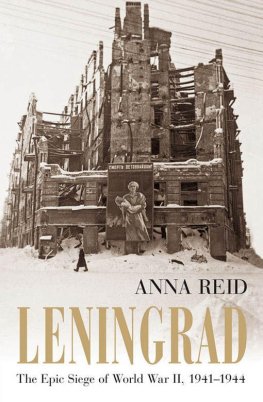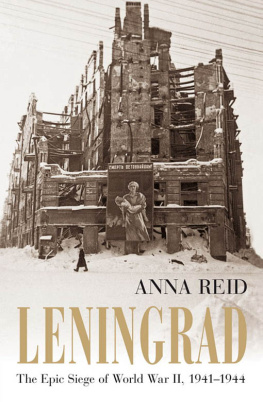Also by Michael Jones
The Kings Mother
Bosworth 1485 Psychology of a Battle
Agincourt 1415 A Battlefield Guide
Stalingrad: How The Red Army Triumphed
LENINGRAD
State of Siege
Michael Jones
JOHN MURRAY
www.johnmurray.co.uk
First published in Great Britain in 2008 by John Murray (Publishers)
An Hachette Livre UK company
Michael Jones 2008
The right of Michael Jones to be identified as the Author of the Work has been asserted by him in accordance with the Copyright, Designs and Patents Act 1988.
All rights reserved. Apart from any use permitted under UK copyright law no part of this publication may be reproduced, stored in a retrieval system, or transmitted, in any form or by any means without the prior written permission of the publisher.
A CIP catalogue record for this title is available from the British Library
Epub ISBN 978-1-84854-121-4
Book ISBN 978-0-7195-6922-7
John Murray (Publishers)
338 Euston Road
London NW1 3BH
www.johnmurray.co.uk
For Edmund and Rufus
Contents
1. An Almost Scientific Method
The German Advance
2. The Biggest Bag of Shit in the Army
Attempts to Defend
3. The Butchers Hook
Ordinary Civilians Experience
4. The Noose
The Blockade Is Not Broken
5. Elenas Sketchbook
The Emerging Horror
6. The Abortionist
The Onset of Mass Starvation
7. One Black Beret
The Authorities Lose Control
8. The Road of Life
Keeping Hope Alive
9. The Symphony
Finding the Will to Survive
10. Operation Spark
The Military Breakthrough
11. Something Necessary
The Siege is Lifted
Preface
In early September 1941 Hitlers armies cut the last roads leading into besieged Leningrad (now St Petersburg) and, in the words of the poet Olga Berggolts, the noose of the blockade tightened around the citys throat. There followed the most horrific siege in history.
This book grew out of my work as a battlefield guide on the Second World Wars Eastern Front. I am grateful to Midas and Holts Battlefield Tours, who helped set up the Siege of Leningrad tour, and to Oleg Alexandrov, of our associated Russian travel company, who first facilitated meetings with Red Army veterans of the fighting. I want to take my readers on a journey, allowing them to experience the exceptional power of this story its sheer horror, but also its capacity to inspire and move us.
My understanding of the siege is informed not by official Soviet records of the peoples valour but by actual accounts of those trapped in the city. I am deeply grateful to three veterans who have been a constant source of encouragement and support: Svetlana Magaeva, who generously gave me access to her psychological profiles of siege survivors; artist Elena Martilla, who allowed me to use her remarkable collection of sketches drawn during the blockade and Irina Skripachyova, head of the St Petersburg Siege Veterans Association, who arranged countless meetings for me. All have enormously enhanced this work.
I use an interview process that I employed with Red Army veterans in my previous book on the battle of Stalingrad, building up a rapport and then working together to establish the psychological contours of the story. I am deeply grateful to the siege survivors who have shared their experiences with me and who have pointed me towards diaries published and unpublished that are honest about the horror descending on the city. Their many contributions are acknowledged in the endnotes. A particularly moving meeting was with survivors of the Lychkovo train massacre on their first ever reunion, in March 2007.
Others have perished, and can speak to us only through their personal papers. I owe another debt of thanks to the director of the Blockade Museum for allowing me access to its many siege diaries and letters. Olga Prut, who oversees the Museum The Muses Were Not Silent, dedicated to cultural life during the siege, and especially the performance of Shostakovichs Seventh, and musicologist Professor Andrei Krukov, have kindly given me additional material.
I also draw on accounts already published. The siege diaries of Vera Inber, Elena Kochina and Elena Skrjabina exist in translation, as does the groundbreaking compilation by Ales Adamovich and Daniil Granin, A Book of the Blockade . Cynthia Simmons and Nina Perlina have also brought out an important collection of siege experi ences. More is available in Russian, and fresh material is emerging all the time the most recent, from the Centre for Oral History at the European University of St Petersburg, came out in 2006. And I have greatly benefited from the major research on the siege undertaken by Richard Bidlack and Nikita Lomagin.
Lena Yakovleva undertook translation and interpretation work in Moscow, and Anna Artiushina did the same in St Petersburg, as well as locating many valuable references for me. Caroline Walton made a number of additional translations and kindly provided me with extracts from Alexander Boldyrevs diary. David M. Glantz and Albert Axell have also helped me with a number of specific points. In general I have followed sources transliterations from Cyrillic script, although on occasions I have standardised spellings of forenames and word endings.
I am grateful to David Glantz for background material on the city map of Leningrad, and to Svetlana Magaeva and Albert Pleysier for help with the maps of the siege lines and the Road of Life. The German advance is drawn from information in Leon Goures The Siege of Leningrad ; the dispositions in Operation Spark are from Robert F. Baumanns Operation Spark: breaking through the siege of Leningrad, in Combined Arms in Battle since 1939 , ed. Roger J. Spillar (Fort Leavenworth, 1992).
I owe a particular debt of gratitude to my agent, Charlie Viney, and to Roland Philipps and Rowan Yapp at John Murray, for their encouragement and support as this work developed. The first three chapters of the book are thematic, and look at the period leading up to the siege of Leningrad from the point of view of the advancing Germans, the Soviet authorities defending the city and finally the ordinary civilians. The subsequent chapters follow a roughly chronological sequence. Their focal point is the three-month period from mid-December 1941 to mid-March 1942 when conditions within Leningrad were at their worst.
In 1969 Harrison Salisbury brought out a book on the siege. Much new material has emerged since, and a complete retelling has now become possible. I am a military historian with a strong interest in battle psychology and the vital role of morale: what motivates people to fight on in the most desperate of circumstances. I look at German strategy and Russian tactics, but concentrate more on the inner battlefield of the psyche. The suffering of Leningrads civilian population and the resilience of many of the survivors move me deeply. Leningraders withstood the siege at extraordinary cost. I want to give readers a fresh understanding of what they endured, and how they emerged victorious.
Timeline
The siege of Leningrad popularly known as the 900 days lasted 872 days, from 8 September 1941, when the Germans first blockaded the city, to 27 January 1944, when their armies were finally repulsed from Leningrad. Here are some of the key dates.
22 June 1941: Germany invades the Soviet Union.
26 June: Mansteins LVI Panzer Corps seizes the Dvina bridges.
Next page










